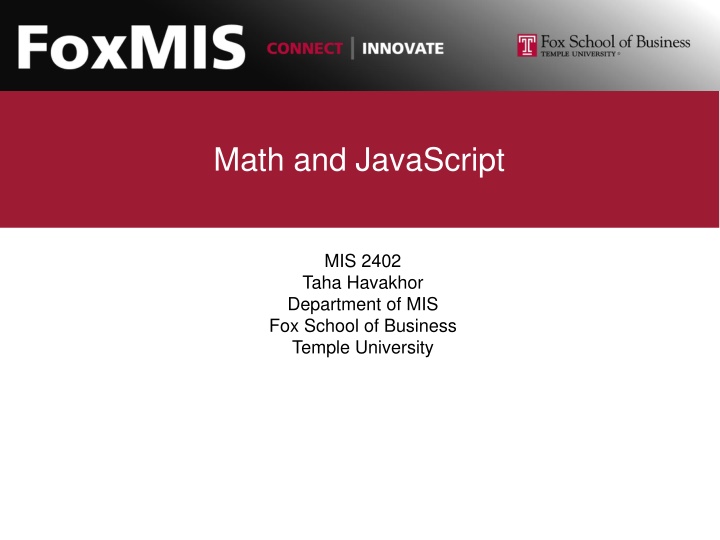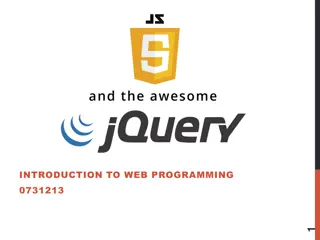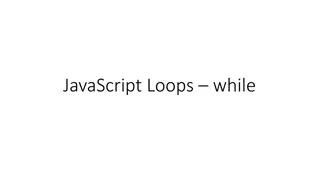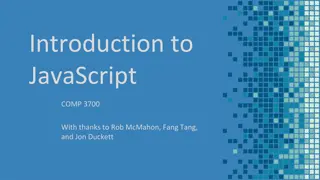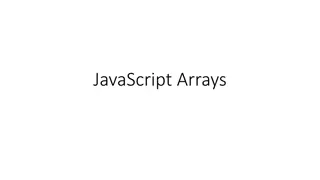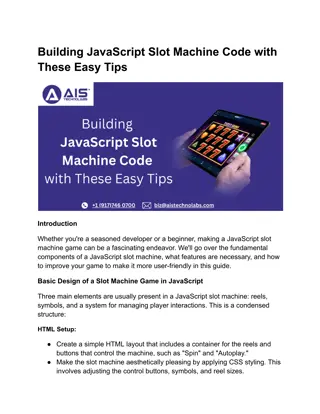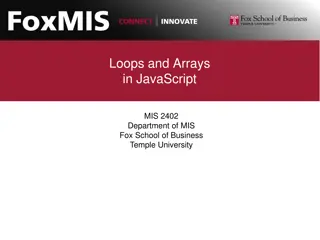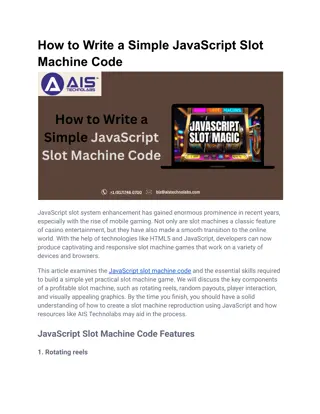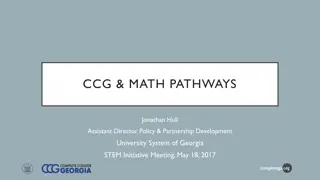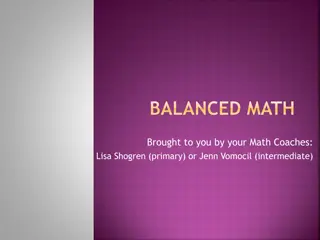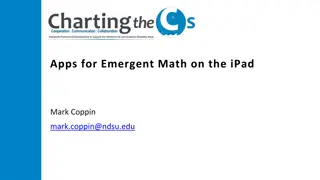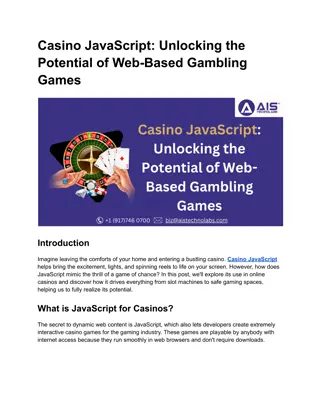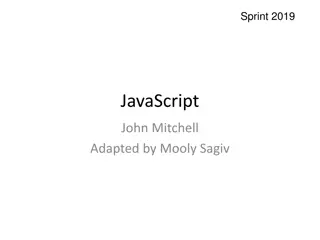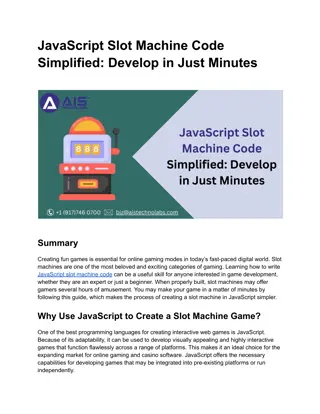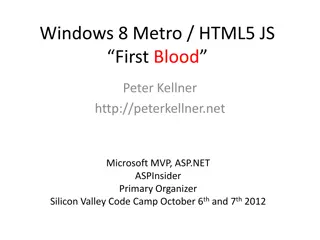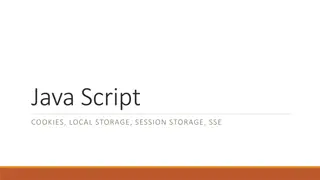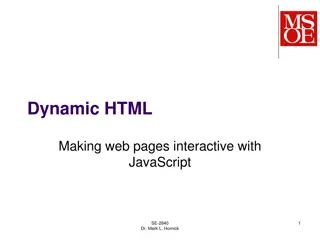Math and JavaScript: Learning Concepts Efficiently
Intersection of math and JavaScript through examples and practical applications. Discover how to convert user input to numbers, use unary operators, and utilize functions like parseInt and parseFloat. Enhance your understanding through creative exercises and problem-solving. Dive into topics such as addition, subtraction, multiplication, and the Math object. Enhance your programming skills in an engaging way.
Download Presentation

Please find below an Image/Link to download the presentation.
The content on the website is provided AS IS for your information and personal use only. It may not be sold, licensed, or shared on other websites without obtaining consent from the author.If you encounter any issues during the download, it is possible that the publisher has removed the file from their server.
You are allowed to download the files provided on this website for personal or commercial use, subject to the condition that they are used lawfully. All files are the property of their respective owners.
The content on the website is provided AS IS for your information and personal use only. It may not be sold, licensed, or shared on other websites without obtaining consent from the author.
E N D
Presentation Transcript
Math and JavaScript MIS 2402 Taha Havakhor Department of MIS Fox School of Business Temple University
Advisory! Often, the best way to understand a programming concept is to construct your own, simple, example of it. As we look at Math and JavaScript today, don t be afraid to do that. It would be smart to revisit this material and make some examples of your own after today s lecture! This approach to learning can be a great time-saver! A few minutes of creative effort can often be a substitute for hours of reading, analyzing someone else s example and/or trying to memorize seemingly random facts. 2
Agenda Math and JavaScript What we have already seen New stuff NaN parseInt parseFloat The Math object A second look at data types 3
What we have already seen: Addition, Subtraction, Multiplication, Division, and Modulus FUN FACT: Did you know that you can perform all these operations from the Web Developer Tools console? Try it! 4
We have also seen: Some shortcuts: i++ and i-- FUN FACT: These are called unary operators. They are called unary because they only take one operand. For example: the ++ operator only works on one operand, the variable i. 5
New Stuff When we get data from user input it is (usually) string input. That means, before we can do math on any number, we need to somehow convert it to a number. We can convert the input implicitly. Consider the following example where the variable x is a string that has been provided by a user. var p = 4 * x; //if x is '5', p will be 20 The conversion was implicit. It happened because the JavaScript language saw the multiplication operator, the number four, and the language parsing process converted the 5 (a string) to a 5 (a number) automatically. 6
A puzzle What if we tried a different formula? Again, in the following example, the variable x is a string that has been provided by a user. var p = x + x + x + x; //if x is '5', p will be '5555' DISCUSS: Why did that happen? What is special about the + operator? You can see this for yourself in perimeter.zip 7
parseInt, parseFloat We can convert the input explicitly. JavaScript gives us the parseInt and parseFloat functions for that. For example Notice that we are not rounding 3.75 we are simply parsing it . extracting only the integer portion of the number. 8
parseInt, parseFloat an example Consider the following example. The computer s memory The code 5 function calculatePerimeter(x) { 5 x = parseInt(x); X 5 x = 5 5 var p = x + x + x + x; p = 20 5 + 5 + 5 + 5 } return p Without the parseInt step, p would have been assigned the result of 5 + 5 + 5 + 5 which is 5555 9
A special case The previous examples work because the user input of 5 in x is a string that can be easily converted into a number. If the user provides a string with a non-numeric value, then the output of the conversion operation will be a special constant called NaN which (you guessed it) is short for Not aNumber. var p = 4 * x; //if x is 'dog', p will be NaN var p = x + x + x + x; //if x is 'dog , //p will be 'dogdogdogdog' x = parseInt(x); //if x is 'dog', x will be NaN x = parseFloat(x); //if x is 'dog', x will be NaN 10
The special thing about NaN NaN has a curious property. All mathematic operations performed on NaN will equal NaN. 11
The exception The exception is (once again!) the + operation. 12
The Math object It s nice that we can do basic arithmetic operations in JavaScript but what if we needed to do something a little more complicated? Like compute x10 or find the square root of a number? Or generate a random number? Or round a number to the closest integer? JavaScript gives us a variety of mathematic constants and functions, all bundled together as part of the Math object. For example, JavaScript gives us the following constants, built right into the language itself. (For the full list, see your textbook!) Property Math.PI Math.SQRT2 What it stands for 3.14159 the ratio of a circle's circumference to its diameter 1.41421 the square root of 2 13
Methods of the Math object The Math object also has a number of methods associated with it. A method is a function that is a property of an object. It takes 0 or more parameters as input, and returns an output. Here are some of the methods you might be interested in. (Again, for the full list, see your textbook!) What it does Math.round(x) Returns x rounded to the nearest integer. Method Math.ceil(x) Returns x rounded up to the next greatest integer. Math.pow(base, power) Returns base returned to some power. Math.sqrt(x) Returns the square root of x. Math.abs(x) Returns the absolute value of x. Math.random() Takes no parameters! Returns a random number between 0 and 1 14
Objects With the introduction of the Math object we now have an opportunity to think about the terminology of objects in general. Objects are simply convenient collections of attributes (like Math.PI) and methods (like Math.random() ). In the next 2 slides we explore the difference between attributes and methods... 15
Objects (attributes) An attribute has a value and that s all. In JavaScript we use a dot ( . ) to separate the object and it s attribute. ObjectName.AttributeName 16
Objects (methods) A method does something. A method will take 0 or more parameters as input and return some output. As with attributes, a dot ( . ) is used to separate the object and its method. ObjectName.MethodName() The number of parameters needed here will depend on the definition of the method! 17
Objects in MIS2402 JavaScript allows you to create your own objects. But we won t be doing that this semester! You should, however, understand the basic terminology and syntax we just described. You should know an object when you see one! JavaScript has lot of built in objects and the Math object is just one of them. 18
Objects An analogy JavaScript is a little bit like your brain there is some functionality that is just built in (like Math.sqrt() to calculate a square root) and there are other things it needs to be told how to do . like compute the area of a circle! Ride a bike Regulate body temp Sing High Hopes Breathe Juggle Chew and Swallow 19
Data types With all this talk about strings and numbers, now would be a good time to revisit the JavaScript Data types. Here are the eight data types of JavaScript: Data Type String Description A sequence of characters. Number A number represented by 64 bits. This data type is used for both integers and floating-point numbers. Boolean A true / false value. Undefined A default value automatically assigned to variables that have just been declared. A way to intentionally indicate that some value does not exist. Null * BigInt * A way to represent really, really big numbers. Good for science stuff. Symbol * An arbitrary and unique value. Object * These data types are not needed in MIS2402 A data type made up of other data types. Source: https://developer.mozilla.org/en-US/docs/Web/JavaScript/Data_structures 20
